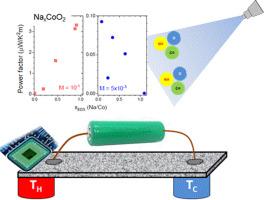Spray pyrolysis as an alternative route to produce thermoelectric layers of NaxCoO2
IF 6.3
2区 材料科学
Q2 CHEMISTRY, PHYSICAL
引用次数: 0
Abstract
This study investigates polycrystalline NaxCoO2 thin films synthesized via spray pyrolysis on glass substrates over a wide compositional range of x. The films were grown using cobalt acetate tetrahydrate and sodium hydroxide as precursors, employing different precursor solution molarities to control the growth dynamics. The characterization of the system was conducted using X-ray Diffraction, Scanning Electron Microscopy, Optical Transmittance, and Raman spectroscopy. Raman spectroscopy revealed oxygen in-plane motion modes under specific excitation wavelengths due to optical resonance conditions and identified the films as γ-NaxCoO2. The growth of γ-NaxCoO2 phase is favored by a high-molarity synthesis mode followed by an oxygen thermal annealing. At room temperature, films with higher sodium content exhibited decreased Seebeck coefficients and electrical resistivity. Notably, a maximum power factor of approximately ∼3.3 µW/K²m was achieved at x = 0.93. Conversely, films prepared at low-molarities presents Na-content Co3O4 phases and Seebeck coefficients up to 500 μV/K yet suffer from poor electrical conductivity. These findings underscore the viability of spray pyrolysis as a scalable method for producing p-type thermoelectric layers such as NaCoO2.

喷雾热解是制备NaxCoO2热电层的替代途径
本研究采用喷雾热解法在玻璃基板上制备了多晶NaxCoO2薄膜,其组成范围为x。该薄膜以四水乙酸钴和氢氧化钠为前驱体,采用不同的前驱体溶液量来控制其生长动力学。利用x射线衍射、扫描电镜、光学透射率和拉曼光谱对该体系进行了表征。拉曼光谱通过光学共振条件揭示了特定激发波长下氧的平面内运动模式,并确定膜为γ-NaxCoO2。γ-NaxCoO2相的生长采用高摩尔浓度的合成模式,然后进行氧热退火。在室温下,钠含量高的薄膜的塞贝克系数和电阻率降低。值得注意的是,在x = 0.93时实现了约3.3 μ W/K²m的最大功率因数。相反,在低摩尔浓度条件下制备的薄膜呈现na - Co3O4相,塞贝克系数高达500 μV/K,但导电性能较差。这些发现强调了喷雾热解作为一种可扩展的生产p型热电层(如NaCoO2)的方法的可行性。
本文章由计算机程序翻译,如有差异,请以英文原文为准。
求助全文
约1分钟内获得全文
求助全文
来源期刊

Surfaces and Interfaces
Chemistry-General Chemistry
CiteScore
8.50
自引率
6.50%
发文量
753
审稿时长
35 days
期刊介绍:
The aim of the journal is to provide a respectful outlet for ''sound science'' papers in all research areas on surfaces and interfaces. We define sound science papers as papers that describe new and well-executed research, but that do not necessarily provide brand new insights or are merely a description of research results.
Surfaces and Interfaces publishes research papers in all fields of surface science which may not always find the right home on first submission to our Elsevier sister journals (Applied Surface, Surface and Coatings Technology, Thin Solid Films)
 求助内容:
求助内容: 应助结果提醒方式:
应助结果提醒方式:


